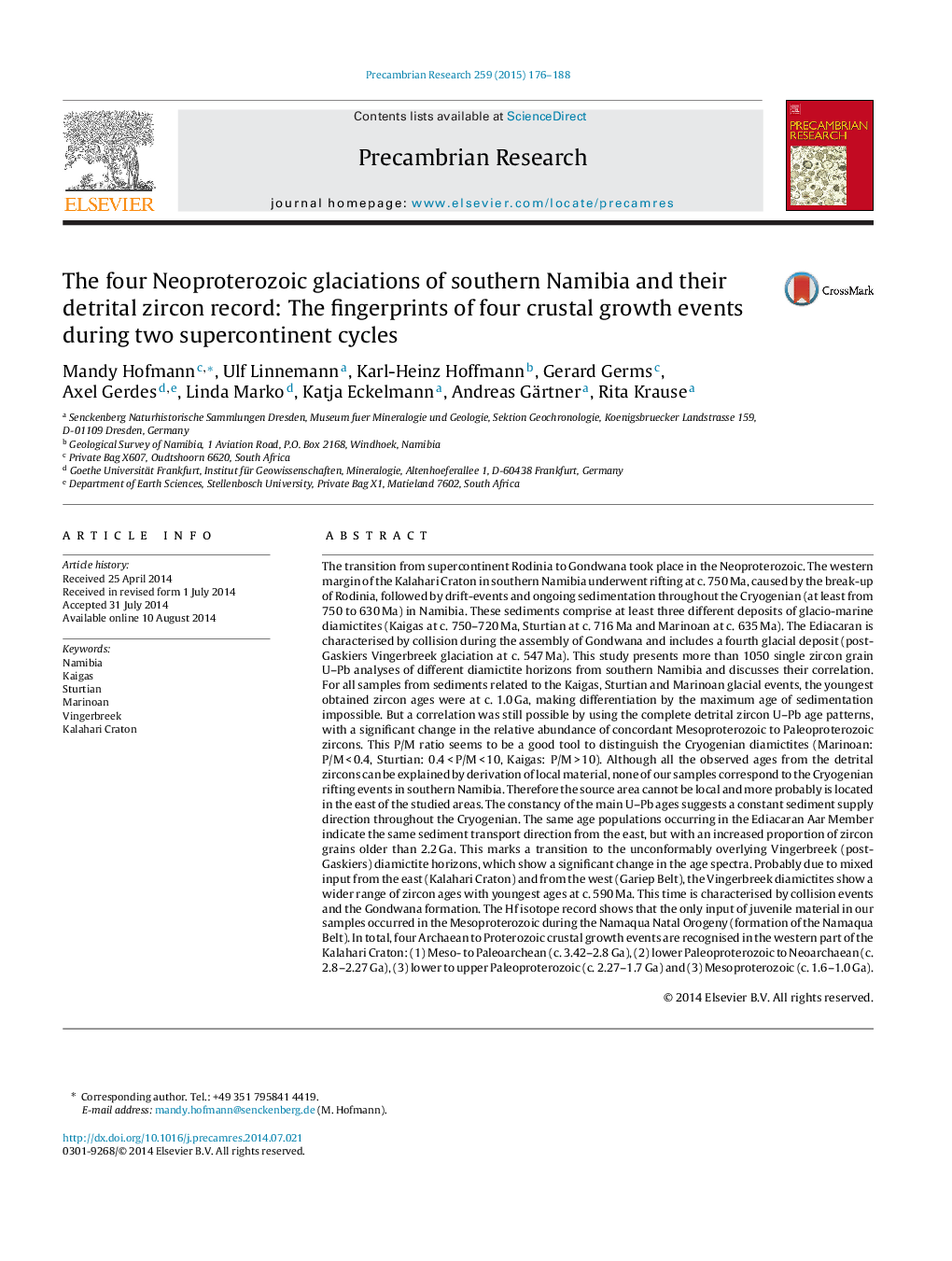| کد مقاله | کد نشریه | سال انتشار | مقاله انگلیسی | نسخه تمام متن |
|---|---|---|---|---|
| 4722836 | 1639616 | 2015 | 13 صفحه PDF | دانلود رایگان |
• There are four distinct glacial layers in S Namibia in the Cryogenian to Ediacaran.
• These diamictites correlate to the Kaigas, Sturtian, Marinoan and Vingerbreek events.
• Correlation is possible by using the P/M ratio of detrital zircon U–Pb ages.
• Sediment supply switched from mainly E to mixing of E + W + N during the Neoproterozoic.
• U–Pb + Hf-data show four crustal growth events (Archaean–Proteroz.) for Kalahari craton.
The transition from supercontinent Rodinia to Gondwana took place in the Neoproterozoic. The western margin of the Kalahari Craton in southern Namibia underwent rifting at c. 750 Ma, caused by the break-up of Rodinia, followed by drift-events and ongoing sedimentation throughout the Cryogenian (at least from 750 to 630 Ma) in Namibia. These sediments comprise at least three different deposits of glacio-marine diamictites (Kaigas at c. 750–720 Ma, Sturtian at c. 716 Ma and Marinoan at c. 635 Ma). The Ediacaran is characterised by collision during the assembly of Gondwana and includes a fourth glacial deposit (post-Gaskiers Vingerbreek glaciation at c. 547 Ma). This study presents more than 1050 single zircon grain U–Pb analyses of different diamictite horizons from southern Namibia and discusses their correlation. For all samples from sediments related to the Kaigas, Sturtian and Marinoan glacial events, the youngest obtained zircon ages were at c. 1.0 Ga, making differentiation by the maximum age of sedimentation impossible. But a correlation was still possible by using the complete detrital zircon U–Pb age patterns, with a significant change in the relative abundance of concordant Mesoproterozoic to Paleoproterozoic zircons. This P/M ratio seems to be a good tool to distinguish the Cryogenian diamictites (Marinoan: P/M < 0.4, Sturtian: 0.4 < P/M < 10, Kaigas: P/M > 10). Although all the observed ages from the detrital zircons can be explained by derivation of local material, none of our samples correspond to the Cryogenian rifting events in southern Namibia. Therefore the source area cannot be local and more probably is located in the east of the studied areas. The constancy of the main U–Pb ages suggests a constant sediment supply direction throughout the Cryogenian. The same age populations occurring in the Ediacaran Aar Member indicate the same sediment transport direction from the east, but with an increased proportion of zircon grains older than 2.2 Ga. This marks a transition to the unconformably overlying Vingerbreek (post-Gaskiers) diamictite horizons, which show a significant change in the age spectra. Probably due to mixed input from the east (Kalahari Craton) and from the west (Gariep Belt), the Vingerbreek diamictites show a wider range of zircon ages with youngest ages at c. 590 Ma. This time is characterised by collision events and the Gondwana formation. The Hf isotope record shows that the only input of juvenile material in our samples occurred in the Mesoproterozoic during the Namaqua Natal Orogeny (formation of the Namaqua Belt). In total, four Archaean to Proterozoic crustal growth events are recognised in the western part of the Kalahari Craton: (1) Meso- to Paleoarchean (c. 3.42–2.8 Ga), (2) lower Paleoproterozoic to Neoarchaean (c. 2.8–2.27 Ga), (3) lower to upper Paleoproterozoic (c. 2.27–1.7 Ga) and (3) Mesoproterozoic (c. 1.6–1.0 Ga).
Journal: Precambrian Research - Volume 259, April 2015, Pages 176–188
